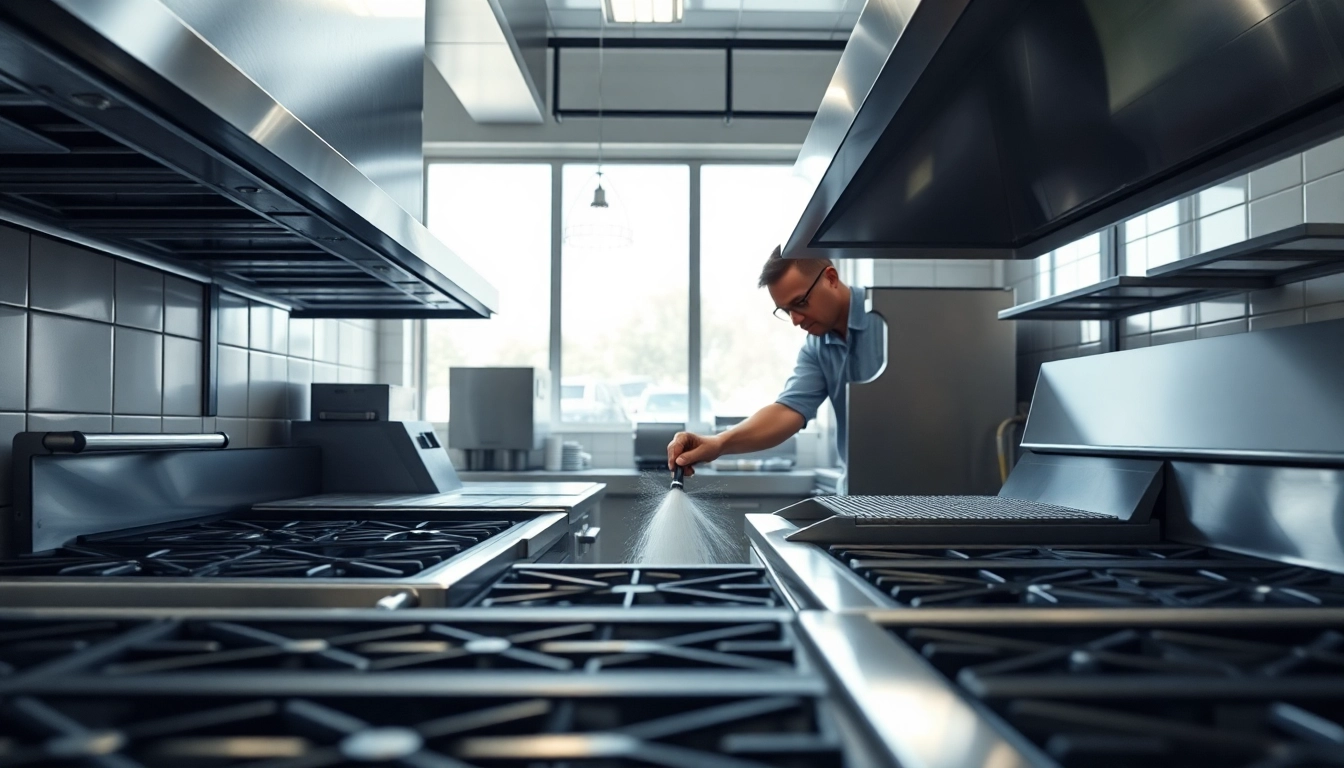Understanding the Importance of Restaurant Cooking Appliance Cleaning
Maintaining a clean and efficient kitchen is crucial for any restaurant’s success. One of the key factors in achieving this is through effective Restaurant Cooking Appliance Cleaning. This process not only helps in adhering to health regulations but also plays a vital role in the longevity of the equipment and the overall efficiency of kitchen operations. In this section, we will explore the significance of keeping cooking appliances clean.
Health and Safety Regulations
The restaurant industry is subject to strict health and safety regulations designed to protect both customers and employees. Regular cleaning of cooking appliances is essential to comply with health codes and avoid potential violations. Accumulated grease, grime, and food residue can pose serious health risks, leading to foodborne illnesses and potential legal repercussions.
Inspections from health authorities often focus on cleanliness, and establishments that fail to meet these standards may face fines, closures, or loss of reputation. By implementing a routine cleaning schedule, restaurants not only ensure compliance but also enhance customer trust and satisfaction.
Maintaining Equipment Longevity
Proper maintenance of cooking appliances goes beyond just keeping them shiny; it extends their operational lifespan and saves on costly replacements. Grease build-up can lead to overheating and equipment failures, which can cost restaurants significant downtime and repair expenses. Regular cleaning keeps appliances working efficiently, reducing the likelihood of breakdowns and increasing the overall return on investment.
For instance, cleaning the flue of a stove can prevent blockages that could potentially start fires, while maintaining griddles and fryers helps maintain their optimal cooking temperature and efficiency.
Enhancing Kitchen Efficiency
A clean kitchen is a productive kitchen. When appliances are regularly cleaned, they perform better, which means food can be prepared faster and with less hassle. Chefs can work more efficiently, reducing the time spent waiting for appliances to heat up or function properly. Furthermore, a clean and organized kitchen allows staff to locate tools and ingredients quickly, streamlining the cooking process and improving workflow.
The overall atmosphere in a clean kitchen can also positively affect employee morale, leading to a more motivated workforce and better service delivery.
Common Cleaning Challenges in Restaurant Cooking Appliances
While the importance of cleaning kitchen appliances is well recognized, there are several challenges that restaurants face when implementing regular cleaning routines. Identifying and addressing these challenges is crucial to maintaining an effective cleaning protocol.
Grease Build-Up Issues
Grease build-up is one of the most common issues faced in restaurant kitchens. Cooking frequently leads to the accumulation of grease on surfaces, particularly on fryers, ranges, and hoods. This accumulation not only poses a fire hazard but also makes cleaning more tedious and time-consuming.
Using appropriate cleaning agents that are designed for grease removal can help mitigate these concerns. Additionally, incorporating regular deep cleaning sessions can significantly reduce grease build-up.
Hard-to-Reach Areas
Many cooking appliances have intricate designs that include hard-to-reach areas which can make cleaning a daunting task. For instance, the nooks and crannies of ovens, behind refrigerators, and under stoves can easily be neglected.
Utilizing specialized tools such as brushes and vacuums designed for kitchen cleaning can help tackle these tough spots. Establishing a periodic deep cleaning schedule enables comprehensive cleaning of all areas, ensuring nothing is overlooked.
Time Constraints in Busy Kitchens
The fast-paced nature of restaurant kitchens often leads to limited time available for thorough cleaning. During peak hours, the focus shifts to food preparation and service, making it challenging to prioritize cleaning tasks.
One solution to this challenge is to establish a cleaning routine during off-peak hours or allocate specific shifts for cleaning purposes. Engaging the entire team in cleaning tasks can also optimize time and ensure that cleaning doesn’t become an afterthought.
Best Practices for Restaurant Cooking Appliance Cleaning
Creating an efficient cleaning protocol requires understanding best practices that ensure thorough and effective cleaning of cooking appliances. This section outlines some essential strategies to consider.
Regular Maintenance Schedules
Establishing a regular maintenance schedule is crucial for ensuring consistent cleaning of cooking appliances. This could include daily, weekly, and monthly cleaning tasks.
Daily tasks might include wiping down surfaces and cleaning grills, while weekly tasks could involve more in-depth cleaning like descaling coffee machines or cleaning out fryers. Monthly deep cleaning could focus on the interior of ovens and the exhaust systems. Having a structured schedule helps in keeping cleaning on track and ensures accountability among staff members.
Choosing the Right Cleaning Supplies
The effectiveness of cleaning often hinges on the products used. It’s essential to select supplies that are appropriate for the specific types of appliances and surfaces. For instance, alkaline cleaners work effectively on grease build-up, while acidic cleaners are suitable for mineral deposits.
Opting for eco-friendly cleaning products not only supports sustainability but also protects employees from harmful chemicals. Always ensure that cleaning agents are food-safe and approved for use in commercial kitchens.
Techniques for Effective Cleaning
Different appliances might require unique cleaning techniques to achieve the best results. For example, using a scrubbing pad for pots and pans is effective, but for delicates like glass cooktops, utilizing a soft cloth and a specialized cleaner is advisable to prevent scratches.
Employing techniques such as soaking equipment in warm, soapy water can help loosen grime and make scrubbing easier. Additionally, using steam cleaning equipment can offer a powerful yet gentle cleaning solution for stubborn stains and dirt.
Implementing a Cleaning Routine for Restaurant Cooking Appliances
Building a comprehensive cleaning routine involves creating step-by-step procedures, checklists, and ensuring staff is trained in cleaning protocols. This consistency not only leads to cleaner appliances but also enhances the overall operations of the kitchen.
Step-by-Step Cleaning Procedures
Defining clear, step-by-step cleaning procedures for each type of equipment is essential for consistency. This should include:
- Gathering necessary cleaning supplies
- Unplugging and prepping equipment for cleaning
- Applying cleaning solutions and letting them act
- Scrubbing surfaces and rinsing thoroughly
- Drying and reassembling appliances
Having these procedures documented ensures that all staff members are on the same page and reduces the likelihood of overlooking any steps in the cleaning process.
Creating a Cleaning Checklist
A cleaning checklist serves as a tangible guide for staff and helps track daily, weekly, and monthly cleaning tasks. This checklist should be visible, easily accessible, and updated as needed.
Including tasks like checking for grease build-up, ensuring all surfaces are sanitized, and inspecting equipment for wear and tear can help maintain high cleaning standards. Furthermore, checking items off the list can provide a sense of completion and accountability among team members.
Training Staff on Cleaning Protocols
Investing in training staff on proper cleaning protocols can significantly improve cleaning outcomes. This training should encompass the importance of cleaning, the specific protocols to be followed, and the effective use of cleaning agents and tools.
Regular training refreshers can reinforce these practices and keep hygiene and safety at the forefront of kitchen operations. Encouraging a culture of cleanliness where every staff member feels responsible can greatly improve both the effectiveness of cleaning routines and the overall kitchen environment.
Measuring Success in Restaurant Cooking Appliance Cleaning
To ensure that cleaning efforts are effective, it is vital to measure success and implement ongoing improvements. This can be achieved through tracking compliance, gathering feedback, and evaluating the impact of cleaning on kitchen operations.
Tracking Hygiene Compliance
Monitoring hygiene compliance regularly provides insights into how well the cleaning protocols are functioning. Conducting regular inspections and audits can help identify areas that may need more attention or improvement.
Utilizing hygiene compliance software or logs can assist in maintaining a systematic approach to tracking cleaning efforts, which can be beneficial during health inspections.
Feedback and Improvement Strategies
Gathering feedback from kitchen staff is crucial in understanding the effectiveness of current cleaning protocols. Regular meetings or informal check-ins can facilitate discussions about challenges and successes related to cleaning practices.
Additionally, developing an anonymous feedback system can encourage employees to share their thoughts and suggestions without fear of repercussions. Being open to constructive criticism can lead to improvements and innovation in cleaning routines.
Evaluating the Impact on Kitchen Operations
Ultimately, the success of cleaning routines should be evaluated based on their impact on kitchen operations. Improved hygiene should correlate with a reduction in food safety incidents, better staff morale, and increased efficiency in food preparation.
Tracking metrics such as the frequency of equipment failures, staff turnover, and customer feedback can provide valuable insights into how cleaning practices are affecting operations. Regular evaluations will also help identify areas for continued improvement and adjustments to cleaning protocols.



